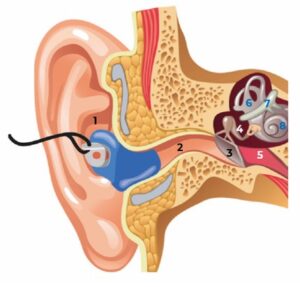The ear is one of the five senses of the human body and as such is exposed to millions of stimuli. The environment is uncontrollable and, therefore, some of the exposures to which this organ is exposed can directly interfere with our health, with some of the damage being irreversible.
Let’s get to know the parts of this organ and how they intervene in sound perception.
How is it structured?
The ear is divided into three main parts
- Outer ear: This is the part responsible for receiving sound and coincides with the outermost part formed by the pinna (1), the visible part of the ear, the ear canal (2) and the eardrum (3).
- Middle ear: Located between the outer and inner ear, it is responsible for transmitting sound energy from the outer ear to the inner ear. The middle ear consists of a chain of three ossicles (4) formed by the malleus, incus and stapes. The Eustachian tube is also part of the middle ear and its protective function is responsible for controlling the pressure behind the eardrum and the middle ear, helping to prevent fluid from entering.
- Inner ear: corresponds to the innermost part of the organ and its function is to transform sounds into nerve signals to be deciphered by the brain. The inner ear consists of the vestibule (6), the auditory nerve (7) and the cochlea (8).

How does sound travel?
Next, let’s look at the path that waves take from the time they are perceived to the time they are interpreted by the brain as sound.
Sound is produced when waves propagate through a medium by agitating it and causing pressure changes in the medium. The propagation medium, e.g. air, serves as a transport medium. This medium is essential for the propagation of waves, because without it there would be no sound and we would not be able to hear anything.
It is the outer ear and the pinna that is responsible for picking up the sound, acting as a receiving screen for capturing the waves. Once collected, they travel through the ear canal towards the tympanic membrane. The ear canal is responsible for conducting the sound waves and protecting the middle ear and helping to regulate the temperature of both sides of the tympanic membrane.
The waves impact on the tympanic membrane causing it to vibrate and transmit the vibrations to the middle ear. The ossicle chain is the mechanism responsible for the transmission of vibrations in the middle ear. It is the malleus, through its base attached to the tympanic membrane towards one of its axes, which comes into contact with the incus and its joint, towards the stapes. It is this last ossicle that transmits the vibrations through its plate inserted in the oval window, transmitting the vibration to the cochlea (inner ear). It is in the cochlea that the acoustic signals (mechanical waves) are converted into electrical impulses, which are then interpreted by our central nervous system. It is also at this stage that sounds are discriminated according to their frequency and coded according to their cadence for better understanding.
What happens when it does not work properly and why?
The importance of hearing care and its relation to proper functioning is given by the hair cells. Around 20,000 cells reside in the organ of Corti (cochlea) and are responsible for this mechanical transformation into an electrical impulse. These cells are particularly fragile and can be destroyed suddenly or progressively when subjected to high sound intensity. Unable to regenerate if damaged, the loss of these cells is involved in the loss of hearing health.
If the hair cells are damaged, they become inaccurate in their function, resulting in hearing difficulties. On occasions when the cells die, they lose the ability to transmit and therefore send the signals received to the brain, compromising hearing.
Hearing loss is irreversible
Good habits and the use of hearing protection are the cornerstones of hearing prevention and conservation.
